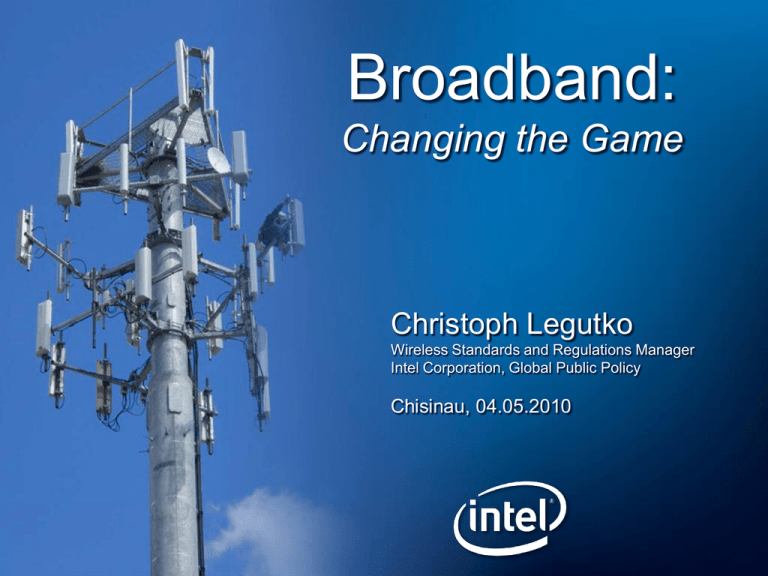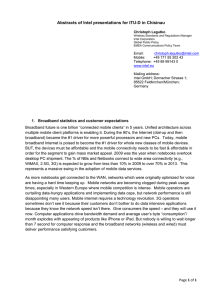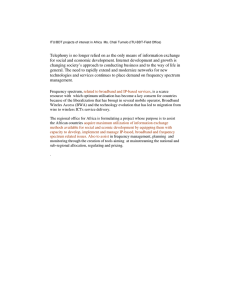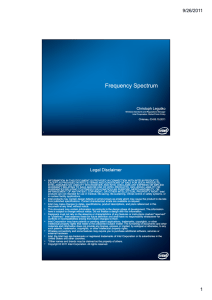Broadband: Changing the Game Christoph Legutko Chisinau, 04.05.2010
advertisement

Broadband: Changing the Game Christoph Legutko Wireless Standards and Regulations Manager Intel Corporation, Global Public Policy Chisinau, 04.05.2010 Intel’s Vision: Three Waves of Internet Access 1,400M 1,200M 10/100/1000 Ethernet ports* 1,000M 800M 600M 400M 200M 0 1995 2002 • Helped define the standard • Drove Integration • Championed Manageability 2008 2016 • Manufacturing in scale • #1 MSS for Ethernet LAN-on-Motherboard* • #1 MSS Network Interface Cards* *Source: Dell’Oro Group, Q1’08; **Source: IDC, Q1’08; Intel estimates; ***Source: Intel Estimates 2020 Intel’s Vision: Three Waves of Internet Access 1,400M 1,200M 10/100/1000 Ethernet ports* 1,000M Wi-Fi ports** 800M 600M 400M 200M 0 1995 2002 2008 2016 • Intel ® Centrino® technology means wireless • Standardization across ecosystems • Drove hot spot footprint • Embedded wireless form factors • Championed Security • Significant Intel Capital investment *Source: Dell’Oro Group, Q1’08; **Source: IDC, Q1’08; Intel estimates; ***Source: Intel Estimates 2020 Intel’s Vision: Three Waves of Internet Access 1,400M 1,200M 10/100/1000 Ethernet ports* 1,000M Wi-Fi ports** 800M broadband ports*** 600M 400M 200M 0 1995 2002 2008 • Defining ITU 4G Standards • Broadband into notebooks • Securing Spectrum 2016 2020 • Driving the Roadmap, Silicon • Open Patent Alliance • Significant Intel Capital investment *Source: Dell’Oro Group, Q1’08; **Source: IDC, Q1’08; Intel estimates; ***Source: Intel Estimates Challenges Mobile Voice vs. Mobile Internet Traffic Equivalents* 1 Smartphone = 30 Handsets 1 Laptop = 450 Handsets ~ 10 Kbps Constant Rate A network optimized for mobile voice cannot handle high numbers of mobile internet users 1-5 Mbps Burst Traffic More Spectrum Needed More Backhaul And Different Network Architecture Required Mobile Internet Requires a Technology Revolution * Source: Cisco Visual Networking Index, July 2009 Governments’ Dilemma Farewell industries Consumer electronics in 70ties Mainframes in 80ties Landline telecommunication in 90ties Broadband telecommunication in 00ties? Automobile industry in 10ties? User experience Revenue generating Applications Voice DSL Copper Video Coax TV Radio Cellular Spectrum Spectrum Changing the mindset and social tensions: in national economies in incumbent organisations Self-managing Networks Demand-oriented Infrastructure & Technology Standardized and interoperable Broadband enables new industries What needs to be done? Network and business model evolution OFDM One broadband network for all: Delivering bits only OFDM WiMAX, LTE Throughput optimised networks Operators without network (Apple) Fragmented networks de-monopolisation HSPA UMTS Incumbents: Monopolistic operators GPRS, EDGE GSM: One narrow band network for all Delivering voice only From voice to bits: ubiquitous service Reconsider Spectrum Philosophy Radio Technologies: service specific Broadcasting bands: Voice bands: Data band: AM, FM, DAB, DVB-T GSM, UMTS, etc. 802.11x Convergence IP $$ Content: Broadcast, Voice, Data OFDM Radio Technologies Coverage/mobile Cellular/mobile Capacity/portable Bands < 1 GHz 1 GHz < bands < 2 GHz 2 GHz < bands Channel Bandwidth ≤ 5 MHz Channel Bandwidth ≤ 10 MHz Channel Bandwidth ≤ 100 MHz Rate ≤2 Mbit/s Data Rate ≤100 Mbit/s Pico: Data Rate ≤1 Gbit/s Digital Dividend Example Germany: Promise to cover remaining ~10% of population with BWA using DD Missing BA hamper establishment of enterprises in rural areas DD: 790-862 MHz as result of WRC-07 arranged with 2x30 MHz + 12 MHz A radio cell with 10 km radius covers 314 km2 area Let’s assume 300 enterprises in this cell requiring 10 Mbit/s transfer rate every This cell must provide 3.000 Mbit/s of continuous transmit in 30 MHz bandwidth State of the art – HSPA – offers ~15 Mbit/s in 5 MHz bandwidth in 500 m radius Broadband Wireless Access is not coverage limited It is capacity limited! Capacity Scenario Deployment GSM/UMTS/HSPA: data throughput too low 2012 we’ll have ~2 billion computers in the world Example Germany: 88% urban population, Berlin: 984km2, 3750 people/km2 Assumptions: cell radius = 0,3km, cell area = 0,3km2, 1000 laptops/km2, 300 laptops/cell, 10 Mbit/s/laptop, 2 bit/Hz/s, Required capacity per cell: 300*10/2 = 1.500 Mbit/s NEEDS OPTICAL FIBRE AND WIDE SPECTRUM CHANNELS TO SUPPORT IT OF & additional cell layer to solve capacity problem low power very small radius dynamic interference avoiding high data throughput Current network and spectrum concepts need improvement to support broadband 2.5 GHz Spectrum arrangement Channel plan according to CEPT Decision (05)05 due to revision, limitation of channel bandwidth/operator and of number of operators Flexible channel plan on market demand, TDD expands down, new TDD allocation at top, 120 MHz duplex gap maintained ITU-R M.1036 Option “c3”, all TDD, best suited for high data throughput, low power cell network layer Source: Ofcom UK In Europe there are two legally incompatible decisions: 1. 2008/477/EC: COMMISSION DECISION of 13 June 2008 on the harmonization of the 2 500-2 690 MHz frequency band for terrestrial systems capable of providing electronic communications services in the Community 2. ECC/DEC/(05)05: ECC Decision of 18 March 2005 on harmonized utilization of spectrum for IMT-2000/UMTS systems operating within the band 2500 – 2690 MHz Let markets arrange the FDD/TDD split in 2.6 GHz band Worldwide broadband spectrum allocation Western Europe 3.4-3.6GHz 3.6-3.8GHz 2.5-2.7GHz TBD Americas 2.5-2.7GHz 3.4-3.6GHz Spectrum Footprint Profile Frequency 3A 2.5 - 2.7GHz 5A/5C 5AL/5BL/5CL: 3.4 - 3.6GHz 3.6 - 3.8GHz 1B 2.3 - 2.4GHz 1A 2.3 - 2.4GHz 1Applies . to TDD Spectra Kilmer Peak APAC 2.5-2.7GHz 2.3-2.4GHz Thank You



